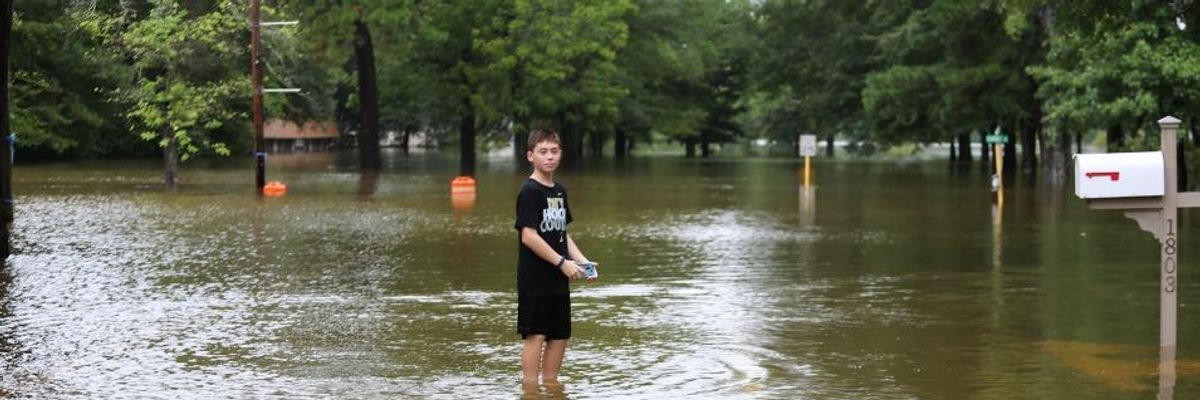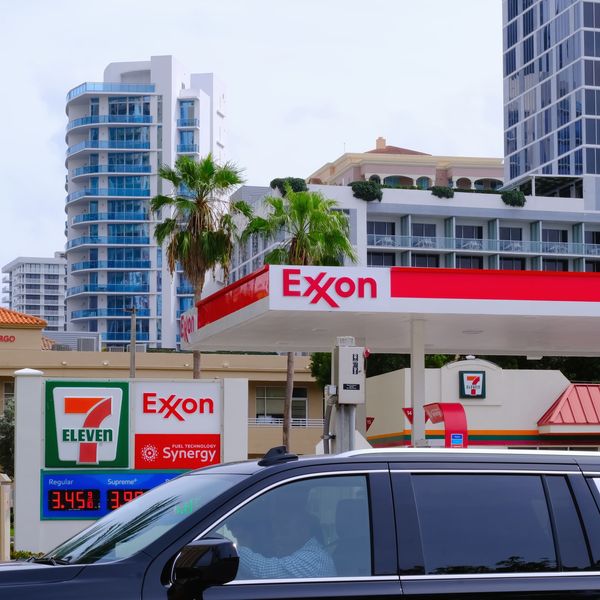
Months after Hurricane Harvey struck the Houston area, an investigation by the Houston Chronicle and the Associated Press shows that the toxic impact of the storm was more widespread than previously reported. (Photo: Jill Carlson/Flickr/cc)
With Full Impact Still Hidden From Public, Report Details 'Environmental Assault' Unleashed by Hurricane Harvey
According to detailed review, nearly half a billion gallons of industrial wastewater mixed with storm water surged out of one chemical plant alone
Seven months after Hurricane Harvey bombarded Houston, Texas for four days, becoming one of the costliest storms in U.S. history, an investigation has begun to uncover the extent of the toxic impact that the hurricane had on the area--home to hundreds of chemical plants and thousands of miles of pipeline as well as 4.7 million residents.
According to the Associated Press and the Houston Chronicle, Harvey unleashed an "environmental assault" on the Houston area, sending millions of gallons of toxic wastewater mixed with storm water into residential neighborhoods--but lax oversight of the energy industry in the area has left residents in the dark about their potential exposure to toxins.
In January, state environmental quality commissioner Bryan Shaw refused to disclose the most destructive spills and their locations to a legislative committee, saying he could not publicly discuss any damage until his staff completed a review.
At the time of the hurricane, regulators publicized just two industrial incidents in the area--an explosion at the Arkema chemical plant in Crosby, Texas, and the damage done to a Superfund site containing dioxin. But those disasters represented just a tiny fraction of the environmental impact of Hurricane Harvey.
A spill at another chemical plant in Baytown, east of the city, caused nearly half a billion gallons of wastewater to flow into surrounding neighborhoods and waterways, while dangerous levels of the carcinogen benzene were released into the atmosphere near a Valero Energy refinery.
A city official's pleas to the Environmental Protection Agency to monitor the air near the Valero facility and determine risks for residents were ignored in early September as the area recovered from the storm, according to the report.
Vinyl chloride and butadiene were also among the chemicals that were released into residential areas as a result of more than 100 toxic spills catalogued by the AP and the Chronicle.
"The public will probably never know the extent of what happened to the environment after Harvey. But the individual companies of course know," Rock Owens, environmental attorney for Harris County, told the news outlets.
In the months following the storm, reads the report, efforts to measure contamination have contrasted sharply with those taken by regulators in 2008 after Hurricane Ike, also in Texas, and in 2005 after Hurricane Katrina.
After the former, "state regulators collected 85 sediment samples to measure the contamination; more than a dozen violations were identified and cleanups were carried out, according to a state review," wrote Frank Bajak and Lise Olsen. Nearly 2,000 soil samples were taken in the months that followed Katrina.
In comparison, "local officials say the state's industry-friendly approach has weakened efforts by the city of Houston and surrounding Harris County to build cases against and force cleanup by the companies, many of them repeat environmental offenders," wrote the reporters.
State and federal regulators have limited their contamination testing mainly to Superfund sites, and have not announced any new regulations to limit future contamination.
"People are left in a state of limbo of not knowing if they were exposed or not--or if they were, what the implications are for their health," said Dr. Nicole Lurie, who has overseen other federal public health responses at the Department of Health and Human Services.
An Urgent Message From Our Co-Founder
Dear Common Dreams reader, The U.S. is on a fast track to authoritarianism like nothing I've ever seen. Meanwhile, corporate news outlets are utterly capitulating to Trump, twisting their coverage to avoid drawing his ire while lining up to stuff cash in his pockets. That's why I believe that Common Dreams is doing the best and most consequential reporting that we've ever done. Our small but mighty team is a progressive reporting powerhouse, covering the news every day that the corporate media never will. Our mission has always been simple: To inform. To inspire. And to ignite change for the common good. Now here's the key piece that I want all our readers to understand: None of this would be possible without your financial support. That's not just some fundraising cliche. It's the absolute and literal truth. We don't accept corporate advertising and never will. We don't have a paywall because we don't think people should be blocked from critical news based on their ability to pay. Everything we do is funded by the donations of readers like you. Will you donate now to help power the nonprofit, independent reporting of Common Dreams? Thank you for being a vital member of our community. Together, we can keep independent journalism alive when it’s needed most. - Craig Brown, Co-founder |
Seven months after Hurricane Harvey bombarded Houston, Texas for four days, becoming one of the costliest storms in U.S. history, an investigation has begun to uncover the extent of the toxic impact that the hurricane had on the area--home to hundreds of chemical plants and thousands of miles of pipeline as well as 4.7 million residents.
According to the Associated Press and the Houston Chronicle, Harvey unleashed an "environmental assault" on the Houston area, sending millions of gallons of toxic wastewater mixed with storm water into residential neighborhoods--but lax oversight of the energy industry in the area has left residents in the dark about their potential exposure to toxins.
In January, state environmental quality commissioner Bryan Shaw refused to disclose the most destructive spills and their locations to a legislative committee, saying he could not publicly discuss any damage until his staff completed a review.
At the time of the hurricane, regulators publicized just two industrial incidents in the area--an explosion at the Arkema chemical plant in Crosby, Texas, and the damage done to a Superfund site containing dioxin. But those disasters represented just a tiny fraction of the environmental impact of Hurricane Harvey.
A spill at another chemical plant in Baytown, east of the city, caused nearly half a billion gallons of wastewater to flow into surrounding neighborhoods and waterways, while dangerous levels of the carcinogen benzene were released into the atmosphere near a Valero Energy refinery.
A city official's pleas to the Environmental Protection Agency to monitor the air near the Valero facility and determine risks for residents were ignored in early September as the area recovered from the storm, according to the report.
Vinyl chloride and butadiene were also among the chemicals that were released into residential areas as a result of more than 100 toxic spills catalogued by the AP and the Chronicle.
"The public will probably never know the extent of what happened to the environment after Harvey. But the individual companies of course know," Rock Owens, environmental attorney for Harris County, told the news outlets.
In the months following the storm, reads the report, efforts to measure contamination have contrasted sharply with those taken by regulators in 2008 after Hurricane Ike, also in Texas, and in 2005 after Hurricane Katrina.
After the former, "state regulators collected 85 sediment samples to measure the contamination; more than a dozen violations were identified and cleanups were carried out, according to a state review," wrote Frank Bajak and Lise Olsen. Nearly 2,000 soil samples were taken in the months that followed Katrina.
In comparison, "local officials say the state's industry-friendly approach has weakened efforts by the city of Houston and surrounding Harris County to build cases against and force cleanup by the companies, many of them repeat environmental offenders," wrote the reporters.
State and federal regulators have limited their contamination testing mainly to Superfund sites, and have not announced any new regulations to limit future contamination.
"People are left in a state of limbo of not knowing if they were exposed or not--or if they were, what the implications are for their health," said Dr. Nicole Lurie, who has overseen other federal public health responses at the Department of Health and Human Services.
Seven months after Hurricane Harvey bombarded Houston, Texas for four days, becoming one of the costliest storms in U.S. history, an investigation has begun to uncover the extent of the toxic impact that the hurricane had on the area--home to hundreds of chemical plants and thousands of miles of pipeline as well as 4.7 million residents.
According to the Associated Press and the Houston Chronicle, Harvey unleashed an "environmental assault" on the Houston area, sending millions of gallons of toxic wastewater mixed with storm water into residential neighborhoods--but lax oversight of the energy industry in the area has left residents in the dark about their potential exposure to toxins.
In January, state environmental quality commissioner Bryan Shaw refused to disclose the most destructive spills and their locations to a legislative committee, saying he could not publicly discuss any damage until his staff completed a review.
At the time of the hurricane, regulators publicized just two industrial incidents in the area--an explosion at the Arkema chemical plant in Crosby, Texas, and the damage done to a Superfund site containing dioxin. But those disasters represented just a tiny fraction of the environmental impact of Hurricane Harvey.
A spill at another chemical plant in Baytown, east of the city, caused nearly half a billion gallons of wastewater to flow into surrounding neighborhoods and waterways, while dangerous levels of the carcinogen benzene were released into the atmosphere near a Valero Energy refinery.
A city official's pleas to the Environmental Protection Agency to monitor the air near the Valero facility and determine risks for residents were ignored in early September as the area recovered from the storm, according to the report.
Vinyl chloride and butadiene were also among the chemicals that were released into residential areas as a result of more than 100 toxic spills catalogued by the AP and the Chronicle.
"The public will probably never know the extent of what happened to the environment after Harvey. But the individual companies of course know," Rock Owens, environmental attorney for Harris County, told the news outlets.
In the months following the storm, reads the report, efforts to measure contamination have contrasted sharply with those taken by regulators in 2008 after Hurricane Ike, also in Texas, and in 2005 after Hurricane Katrina.
After the former, "state regulators collected 85 sediment samples to measure the contamination; more than a dozen violations were identified and cleanups were carried out, according to a state review," wrote Frank Bajak and Lise Olsen. Nearly 2,000 soil samples were taken in the months that followed Katrina.
In comparison, "local officials say the state's industry-friendly approach has weakened efforts by the city of Houston and surrounding Harris County to build cases against and force cleanup by the companies, many of them repeat environmental offenders," wrote the reporters.
State and federal regulators have limited their contamination testing mainly to Superfund sites, and have not announced any new regulations to limit future contamination.
"People are left in a state of limbo of not knowing if they were exposed or not--or if they were, what the implications are for their health," said Dr. Nicole Lurie, who has overseen other federal public health responses at the Department of Health and Human Services.

